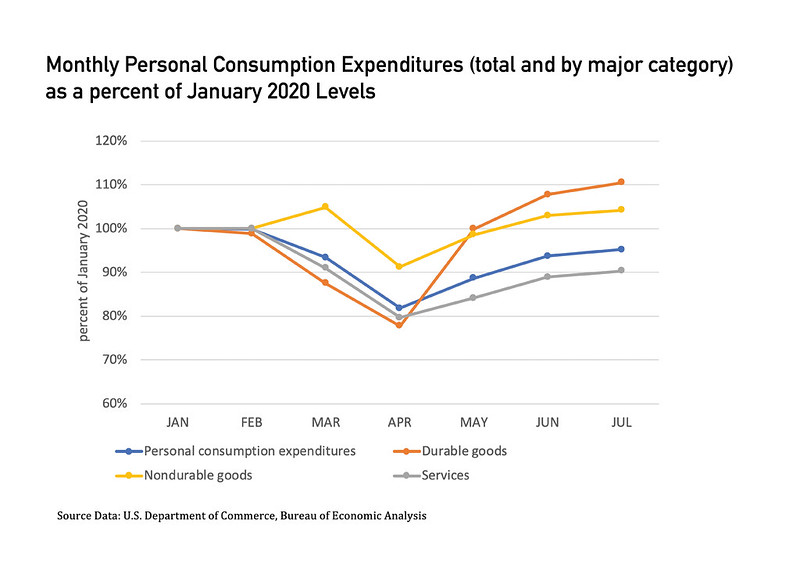Sept. 8, 2020
Post-COVID income, spending inch upward; both still lag below pre-pandemic levels
By Mary Hightower
U of A System Division of Agriculture
Fast facts
- Spending on big-ticket items bucks typical recession behavior
(522 words)
(Download this story in MS Word format here.)
FAYETTEVILLE, Ark. — Personal income and spending have grown for three consecutive months; however, wages, salaries and rental incomes still lag below pre-COVID-19 levels, according to the latest Bureau of Economic Analysis “Personal Income and Outlays” report.
The report provides a comprehensive look at sources of income as well as major expenditure items for households, providing interesting insights into how COVID-19 continues to affect the economy. The Bureau of Economic Analysis is part of the federal Department of Commerce.
“The headline from the report was that personal income increased by 0.4 percent in July compared to the prior month,” economist John Anderson said. “Most pre-report estimates were calling for a slight decline, so the report was a generally positive surprise for the market. Adding to the positive tone, the increase in personal income was entirely accounted for by an increase in worker compensation as opposed to government transfers.”
Anderson is head of the agricultural economics and agribusiness department for the University of Arkansas System Division of Agriculture and the Dale Bumpers College of Agricultural Food and Life Sciences. He has been providing pandemic-related analyses of the economy since March.
“Total personal income is well above its pre-COVID level because government social benefits remain historically quite high,” he said. Federal COVID-related “transfer payments did decline in July compared to June, primarily the result of a decline in unemployment benefits, but they remain far above pre-COVID levels.”
For example, in January, government social benefits totaled $3,158 billion. In July, government social benefits amounted to $4,867 billion, an increase of 54 percent, due mostly to enhanced unemployment benefits.
Consumer spending
Anderson called consumer spending in July “somewhat unusual.”
“Spending on durable goods has been quite strong, considering that we are currently in a rather sharp recession,” he said. “Spending on big-ticket items that we would normally expect to struggle in a recessionary environment has grown markedly over the course of the year, and more specifically, since April.”
Boats rise with the tide
Anderson said, for example, spending on pleasure boats increased this year. He selected boats because they are “kind of an iconic discretionary purchase. However, the same basic point could be made with RVs or motorcycles as well. A lot more spending growth in these categories than I would expect in the middle of a ‘normal’ recession.
“For example, expenditures on pleasure boats were 36 percent higher in July than in January,” Anderson said. “In contrast, over the course of the last major recession — the Great Recession in 2007-2010 — spending in that category fell by about half.”
When compared to July 2019, boat sales in July 2020 were up almost 31 percent. While the differences between boat sales in January and July may seem simply seasonal, the BEA statistics are adjusted for seasonality. For comparison, between January 2019 and July 2019, boat sales declined 4 percent.
Travel and leisure spending remained severely curtailed, however.
“Until consumers regain the confidence to resume social exposure — at work and in recreational settings — and until social distancing guidelines allow such a resumption, spending in these categories will continue to lag,” Anderson said.
To learn about extension and research programs in Arkansas, visit https://uada.edu/.
Follow us on Twitter at @AgInArk, @uaex_edu or @ArkAgResearch.
About the Division of Agriculture
The University of Arkansas System Division of Agriculture’s mission is to strengthen agriculture, communities, and families by connecting trusted research to the adoption of best practices. Through the Agricultural Experiment Station and the Cooperative Extension Service, the Division of Agriculture conducts research and extension work within the nation’s historic land grant education system.
The Division of Agriculture is one of 20 entities within the University of Arkansas System. It has offices in all 75 counties in Arkansas and faculty on five system campuses.
Pursuant to 7 CFR § 15.3, the University of Arkansas System Division of Agriculture offers all its Extension and Research programs and services (including employment) without regard to race, color, sex, national origin, religion, age, disability, marital or veteran status, genetic information, sexual preference, pregnancy or any other legally protected status, and is an equal opportunity institution.
# # #
Media Contact: Mary Hightower
Chief Communications Officer
University of Arkansas System Division of Agriculture
mhightower@uada.edu
501-671-2006
